Maytag WTW6120HC, WTW7120HC, WTW7120HW, MVW7232HW, MVW6230RHW User Manual
...
WASHER INSTALLATION & CARE INSTRUCTION MANUAL MANUEL D’INSTRUCTION D’INSTALLATION
ET D’ENTRETIEN DE LA LAVEUSE
MANUAL DE INSTRUCCIONES PARA LA INSTALACIÓN
Y EL CUIDADO DE LA LAVADORA
Table of Contents |
|
WASHER SAFETY.......................................................... |
2 |
INSTALLATION REQUIREMENTS................................ |
3 |
Tools and parts.......................................................... |
3 |
Location Requirement.............................................. |
4 |
Drain System............................................................. |
4 |
Electrical Requirements........................................... |
5 |
INSTALLATION INSTRUCTIONS.................................. |
5 |
Connect Drain Hose................................................. |
6 |
Connect Inlet Hoses................................................. |
7 |
Level Washer............................................................. |
8 |
Complete Installation Checklist.............................. |
9 |
WASHER MAINTENANCE AND CARE......................... |
9 |
Water Inlet Hoses..................................................... |
9 |
Washer Care.............................................................. |
9 |
Non-Use And Vacation Care ................................. |
10 |
Cleaning Your Dispenser........................................ |
10 |
Winter Storage Care............................................... |
11 |
Transporting Your Washer..................................... |
11 |
Reinstalling/Using Washer Again.......................... |
11 |
Table des matières |
|
SÉCURITÉ DE LA LAVEUSE....................................... |
12 |
EXIGENCES D’INSTALLATION................................... |
13 |
Outils et pièces....................................................... |
13 |
Exigences d’emplacement..................................... |
14 |
Système de vidange............................................... |
14 |
Spécifications électriques..................................... |
15 |
INSTRUCTIONS D’INSTALLATION............................. |
15 |
Raccordement du tuyau de vidange..................... |
16 |
Raccordement des tuyaux d’alimentation............ |
17 |
Mise à niveau de la laveuse................................... |
18 |
Liste de vérification pour installation terminée... |
19 |
ENTRETIEN ET RÉPARATION DE LA LAVEUSE....... |
19 |
Tuyaux d’arrivée d’eau........................................... |
19 |
Entretien de la laveuse........................................... |
19 |
Non utilisation et entretien en période |
|
de vacances............................................................ |
20 |
Nettoyage du distributeur...................................... |
20 |
Entretien pour entreposage hivernal.................... |
21 |
Transport de la laveuse.......................................... |
21 |
Réinstallation/réutilisation de la laveuse.............. |
21 |
Índice |
|
SEGURIDAD DE LA LAVADORA................................. |
22 |
REQUISITOS DE INSTALACIÓN................................. |
23 |
Herramientas y piezas............................................ |
23 |
Requisitos de ubicación......................................... |
24 |
Sistema de desagote.............................................. |
24 |
Requisitos eléctricos.............................................. |
25 |
INSTRUCCIONES DE INSTALACIÓN......................... |
26 |
Conecte la manguera de desagote....................... |
27 |
Conexión de las mangueras de entrada............... |
27 |
Nivelación de la lavadora....................................... |
28 |
Lista de control de la instalación terminada........ |
29 |
MANTENIMIENTO Y CUIDADO DE LA LAVADORA..30 |
|
Mangueras de entrada de agua............................ |
30 |
Cuidado de la lavadora.......................................... |
30 |
Cuidado durante períodos sin uso y en |
|
las vacaciones......................................................... |
31 |
Limpieza del depósito............................................ |
31 |
Cuidado para el almacenamiento durante |
|
el invierno................................................................ |
31 |
Transporte de la lavadora...................................... |
31 |
Cómo reinstalar o usar la lavadora nuevamente.... |
32 |
W11197727A |
|
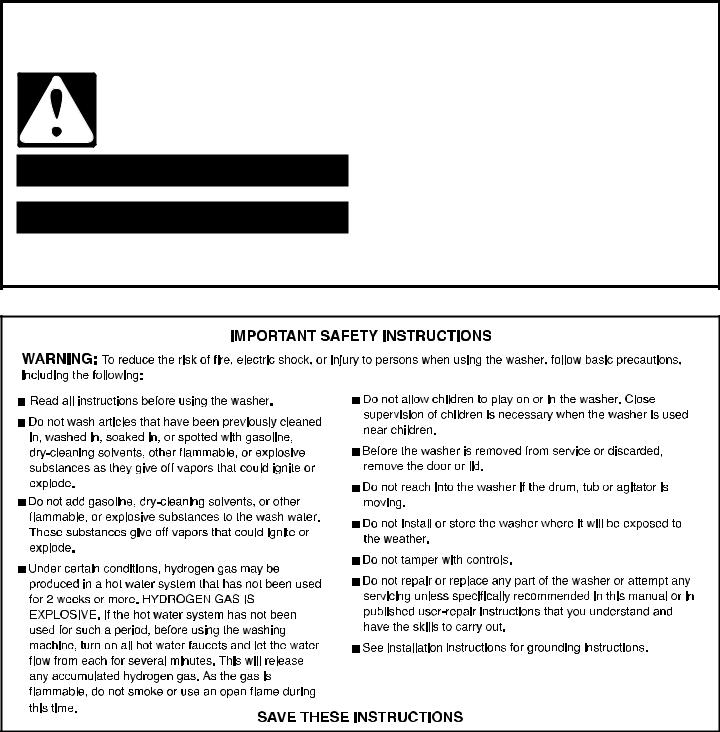
WASHER SAFETY
Your safety and the safety of others are very important.
many important safety messages in this manual and on your appliance. Always read and obey all safety
safety alert symbol.
alerts you to potential hazards that can kill or hurt you and others.
messages will follow the safety alert symbol and either the word “DANGER” or “WARNING.” mean:
 DANGER
DANGER  WARNING
WARNING
You can be killed or seriously injured if you don't immediately follow instructions.
You can be killed or seriously injured if you don't follow instructions.
All safety messages will tell you what the potential hazard is, tell you how to reduce the chance of injury, and tell you what can happen if the instructions are not followed.
2
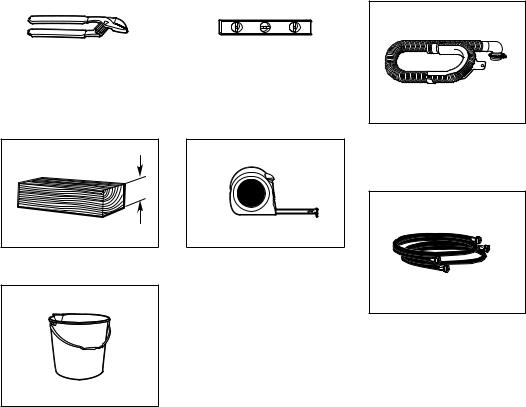
INSTALLATION REQUIREMENTS
Tools and Parts
Gather required tools and parts before starting installation.
Tools needed |
|
|
Parts supplied: |
|
|
|
|
|
|
|
NOTE: All parts supplied for installation are in cardboard |
|
|
||
|
|
|
insert in the top of the washer. |
|
|
|
|
Pliers that open to 13/4" |
Level |
4" min. |
Wood Block |
Ruler or measuring tape |
Drain hose with clamp,
U-form, and cable tie
Parts needed (Not supplied with washer):
Inlet hoses with flat washers
Bucket
3
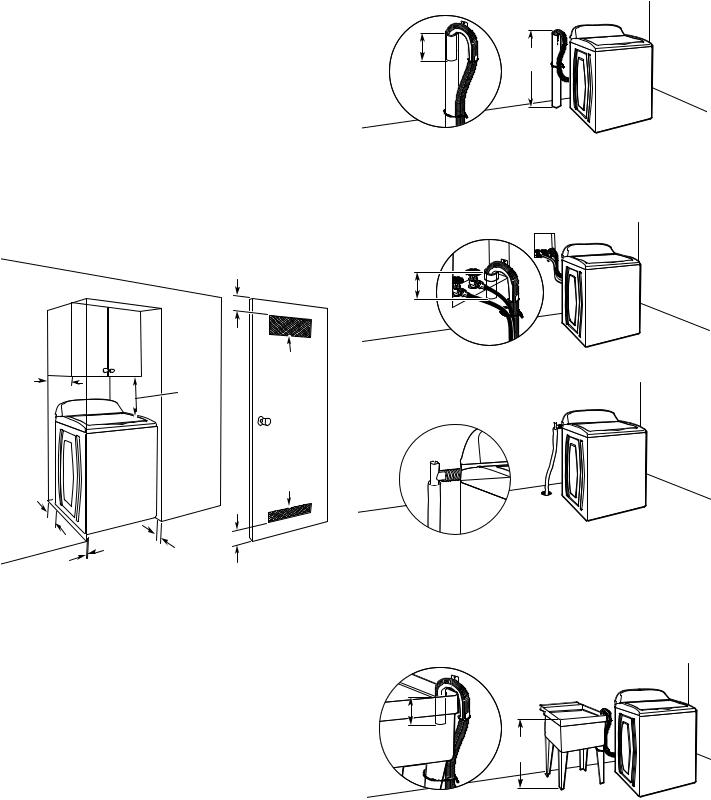
Location Requirement
Select proper location for your washer to improve performance and minimize noise and possible “washer walk”. Install your washer in a basement, laundry room, closet, or recessed area.
You will need
ʍʍ A water heater set to 120°F (49°C).
ʍʍ A grounded electrical outlet located within 4 ft. (1.2 m) of power cord on back of washer.
ʍʍ Hot and cold water faucets located within 3 ft. (0.9 m) of hot and cold water fill valves on washer, and water pressure of 20-100 psi (138-690 kPa).
ʍʍ A level floor with maximum slope of 1" (25 mm) under entire washer. Installing on carpet is not recommended.
ʍʍ Floor must support washer’s total weight (with water and load) of 315 lbs (143 kgs).
IMPORTANT: Do not install, store, or operate washer where it will be exposed to weather or in temperatures below
32°F (0°C).Water remaining in washer after use may cause damage in low temperatures. See the “Winter Storage Care” section for winterizing information.
Proper installation is your responsibility.
Recessed area or closet installation
3" (76 mm)
14" max. |
48 in.2 |
(356 mm) |
(310 cm2) |
|
20" |
|
(508 mm) |
24 in.2 5" (155 cm2)
(127 mm)
|
1" |
|
1" |
(25 mm) |
3" |
(25 mm) |
|
(76 mm) |
Dimensions show recommended spacing allowed, except for closet door ventilation openings which are minimum required. This washer has been tested for installation with spacing of
0" (0 mm) clearance on the sides. Consider allowing more space for ease of installation and servicing, and spacing for companion appliances and clearances for walls, doors, and floor moldings.
Add spacing of 1" (25 mm) on all sides of washer to reduce noise transfer. If a closet door or louvered door is installed, top and bottom air openings in door are required.
Drain System
Drain system can be installed using a floor drain, wall standpipe, floor standpipe, or laundry tub. Select method you need.
Floor standpipe drain system
|
39" |
4.5" |
(990 mm) |
(114 mm) |
|
Minimum diameter for a standpipe drain: 2" (51 mm). Minimum carry-away capacity: 17 gal. (64 L) per minute. Top of standpipe must be at least 39" (990 mm) high; install no higher than
96" (2.44 m) from bottom of washer. If you must install higher than 96" (2.44 m), you will need a sump pump system.
Wall standpipe drain system
4.5" (114 mm)
See requirements for floor standpipe drain system.
Floor drain system
Floor drain system requires a Siphon Break Kit
(Part Number 285834), 2 Connector Kits (Part Number 285835), and an Extension Drain Hose (Part Number 285863) that may be purchased separately. To order, please see toll-free phone numbers in “Assistance or Service” section. Minimum siphon break: 28" (710 mm) from bottom of washer. (Additional hoses may be needed.)
Laundry tub drain system
4.5" |
|
(114 mm) |
39" |
(990 mm)
Minimum capacity: 20 gal. (76 L). Top of laundry tub must be at least 39" (990 mm) above floor; install no higher than
96" (2.44 m) from bottom of washer.
IMPORTANT: To avoid siphoning, no more than 4.5" (114 mm) of drain hose should be inside standpipe or below the top of wash tub. Secure drain hose with cable tie.
4
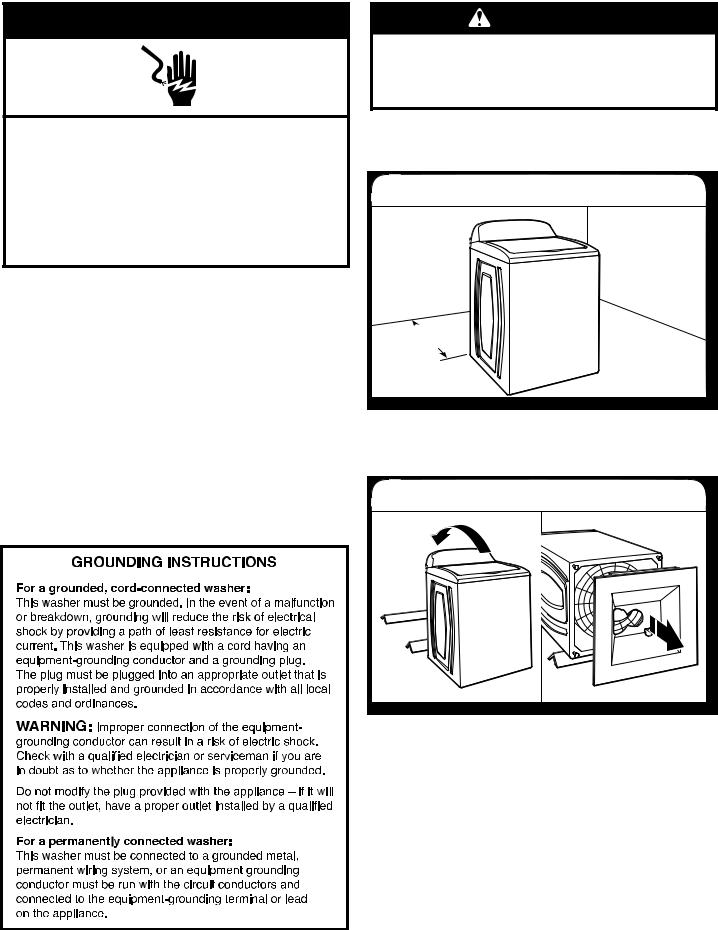
Electrical Requirements
 WARNING
WARNING
Electrical Shock Hazard Plug into a grounded 3 prong outlet. Do not remove ground prong.
Do not use an adapter.
Do not use an extension cord.
Failure to follow these instructions can result in death, fire, or electrical shock.
ʍʍ A 120 V, 60 Hz., AC only, 15 or 20 A, fused electrical supply is required. A time-delay fuse or circuit breaker is recommended. It is recommended that a separate circuit breaker serving only this appliance be provided.
ʍʍ This washer is equipped with a power supply cord having a 3 prong grounding plug.
ʍʍ To minimize possible shock hazard, the cord must be plugged into a mating, 3 prong, grounding-type outlet, grounded in accordance with local codes and ordinances. If a mating outlet is not available, it is the personal responsibility and obligation of the customer to have the properly grounded outlet installed by a qualified electrician.
ʍʍ If codes permit and a separate ground wire is used, it is recommended that a qualified electrician determine that the ground path is adequate.
ʍʍ Do not ground to a gas pipe.
ʍʍ Check with a qualified electrician if you are not sure the washer is properly grounded.
ʍʍ Do not have a fuse in the neutral or ground circuit.
INSTALLATION INSTRUCTIONS
ARNING
Excessive Weight Hazard
Use two or more people to move and install washer. Failure to do so can result in back or other injury.
Before you start: Remove shipping materials.
It is necessary to remove all shipping materials for proper operation and to avoid excessive noise from washer.
1. Move washer
 48" (1.2 m)
48" (1.2 m)
Move washer to within 4 ft. (1.2 m) of its final location; it must be in a fully upright position.
NOTE: To avoid floor damage, set washer onto cardboard before moving it and make sure lid is taped shut.
2. Remove shipping base
To avoid damaging floor, place cardboard supports from shipping carton on floor behind washer. Tip washer back and place on cardboard supports. Remove shipping base. Set washer upright.
IMPORTANT: Removing shipping base is necessary for proper operation. If your washer includes a sound shield, please refer to the instructions included with the sound shield to install it at this time.
5
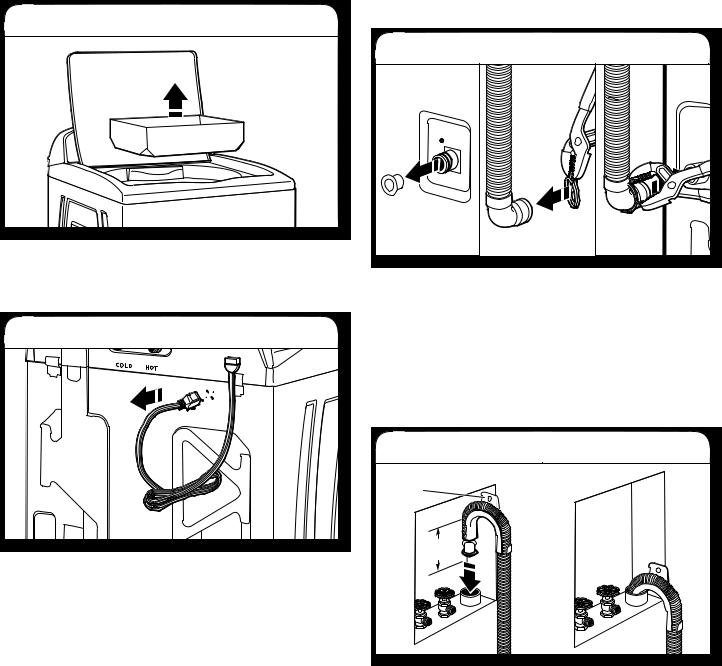
3. Connect Drain Hose
Remove packing tray from tub
5. Attach drain hose to drain port
Remove tape from washer lid, open lid, and remove cardboard packing tray from tub. Remove all other packaging materials from washer tub. Be sure to remove all parts from tray.
NOTE: Keep tray in case you need to move washer later.
4. Free power cord
Firmly grasp power cord plug and pull to free from rear panel. Gently place power cord over console to allow free access to back of washer.
Remove the red plastic plug from the black drain port on the back of the washer.
If clamp is not already in place on elbow end of drain hose, slide it over end as shown. Squeeze clamp with pliers and slide black elbow end of drain hose onto black drain port and secure with clamp.
For a laundry tub or standpipe drain, go to step 6.
For a floor drain, remove the preinstalled drain hose form as shown in Step 7. You may need additional parts with separate directions. See the “Tools and Parts” section.
6. Place drain hose in standpipe
Drain hose form
4.5"  (114 mm)
(114 mm)
Place hose into standpipe (shown in picture) or over side of laundry tub.
IMPORTANT: 4.5" (114 mm) of drain hose should be inside standpipe; do not force excess hose into standpipe or lay on bottom of laundry tub. Drain hose form must be used.
6
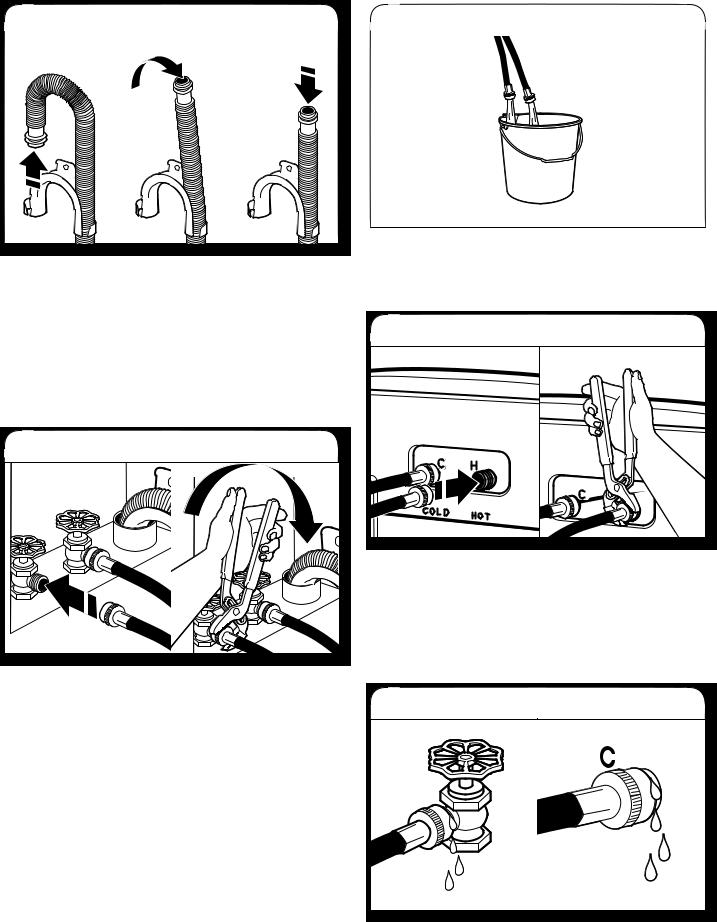
7. Remove drain hose form |
|
9. Clear water lines |
||
(floor drain installations only) |
|
|
||
|
|
|
|
|
|
|
|
|
|
For floor drain installations, you will need to remove the drain hose form from the end of the drain hose. You may need additional parts with separate directions. See the “Tools and Parts” section.
Connect Inlet Hoses
Washer must be connected to water faucets with new inlet hoses with flat washers (not provided). Do not use old hoses.
NOTE: Both hoses must be attached and have water flowing to inlet valves. If you are only connecting to a cold water faucet, you must use a Y-adapter (not provided).
8. Connect inlet hoses to water faucets
Attach hose to hot water faucet. Screw on coupling by hand until it is seated on washer. Use pliers to tighten couplings an additional two-thirds turn. Repeat this step with second hose for cold water faucet.
IMPORTANT: Do not overtighten or use tape or sealants on valve when attaching to faucets or washer. Damage can result.
Run water for a few seconds through hoses into a laundry tub, drainpipe, or bucket to avoid clogs. Water should run until clear.
Make note of which hose is connected to hot water to help in attaching hoses to washer correctly.
10. Connect inlet hoses to washer
Attach hot water hose to hot water inlet valve marked with a red ring. Screw coupling by hand until it is snug. Use pliers to tighten couplings an additional two-thirds turn. Repeat with cold water inlet valve.
IMPORTANT: To reduce risk of hose failure, replace the hoses every five years. Record hose installation or replacement dates for future reference.
ʍʍ Periodically inspect and replace hoses if bulges, kinks, cuts, wear, or leaks are found.
11. Check for leaks
Turn on water faucets to check for leaks. A small amount of water may enter washer. It will drain later.
7

12. Secure drain hose
Laundry Tub |
Standpipe |
Wall |
4.5"4.5" |
4.5" |
4.5" |
(114 mm) |
||
(114 |
|
(1143 mm) |
Secure drain hose to laundry tub leg, drain standpipe, or inlet hoses for wall standpipe with cable tie.
Level Washer
IMPORTANT: Level washer properly to reduce excess noise and vibration.
13. Check levelness of washer
Place level here |
Place level here |
Move the washer to its final location. Place a level on top edges of washer. Use side seam as a guide to check levelness of sides. Check levelness of front using lid, as shown. Rock washer back and forth to make sure all four feet make solid contact with floor. If washer is level, skip to step 15.
|
|
|
|
|
|
|
|
|
|
|
|
|
|
|
|
|
|
|
|
|
|
|
|
|
|
|
|
|
|
|
|
|
Not Level |
LEVEL |
|
Not Level |
|||||||
14. Adjust leveling feet
Models with plastic feet
If washer is not level:
Use adjustable pliers to turn the plastic leveling foot counterclockwise to lower the washer or clockwise to raise the washer. On all models, recheck levelness of washer and repeat as needed.
HELPFUL TIPS:
ʍʍ You may need to adjust two different feet to level your unit. Ensure each foot remains secured to the washer’s base.
ʍʍ You may want to prop up the front of the washer about 4" (102 mm) with a wood block or similar object that will support the weight of the washer when making the adjustments.
 WARNING
WARNING
Electrical Shock Hazard Plug into a grounded 3 prong outlet. Do not remove ground prong.
Do not use an adapter.
Do not use an extension cord.
Failure to follow these instructions can result in death, fire, or electrical shock.
15. Plug into a grounded 3 prong outlet
8
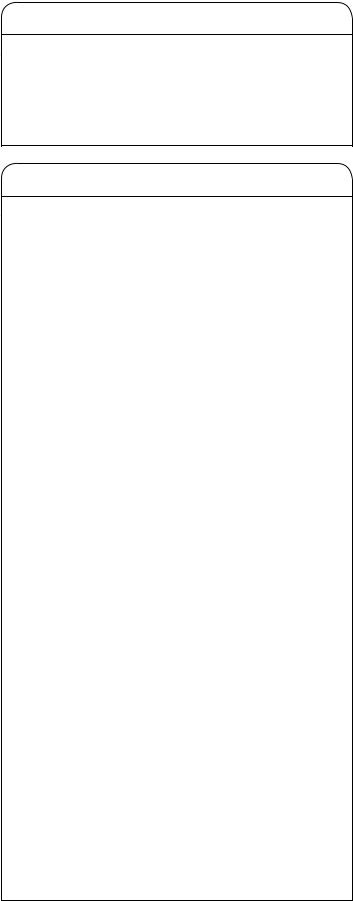
Complete Installation Checklist
Check electrical requirements. Be sure you have correct electrical supply and recommended grounding method.
Check that all parts are now installed. If there is an extra part, go back through steps to see what was skipped.
Check that you have all of your tools.
Check that shipping materials were completely removed from washer.
Check that the washer is level.Check that water faucets are on.
Check for leaks around faucets and inlet hoses.
Remove protective film from console and any tape remaining on washer.
Check that washer is plugged into a grounded 3 prong outlet.Dispose of/recycle all packaging materials.
Read the “Washer Care” section in this book.
To test and clean your washer, measure 1/2 of normal recommended amount of powdered or liquid detergent and pour it into washer basket or detergent dispenser
(on some models). Close lid. Select any cycle. Start washer and allow to complete full cycle.
WASHER MAINTENANCE AND CARE
WATER INLET HOSES
Replace inlet hoses after 5 years of use to reduce the risk of hose failure. Periodically inspect and replace inlet hoses if bulges, kinks, cuts, wear, or leaks are found.
When replacing your inlet hoses, mark the date of replacement on the label with a permanent marker.
NOTE: This washer does not include inlet hoses. See the “Installation & Care Instructions Manual” for more information.
WASHER CARE
Recommendations to Help Keep Your Washer Clean and Performing at its Best
1.Always use High Efficiency (HE) detergents and follow the HE detergent manufacturer’s instructions regarding the amount of HE detergent to use. Never use more than the recommended amount because that may increase the rate at which detergent and soil residue accumulate inside your washer, which in turn may result in undesirable odor.
2.Use warm and hot wash water settings sometimes (not exclusively cold water washes), because they do a better job of controlling the rate at which soils and detergent accumulate.
3.Always leave the washer lid open between uses to help dry out the washer and prevent the buildup of odor-causing residue.
Cleaning Your Top Loading Washer
Read these instructions completely before beginning the routine cleaning processes recommended below. This Washer Maintenance Procedure should be performed, at a minimum, once per month or every 30 wash cycles,
whichever occurs sooner, to control the rate at which soils and detergent may otherwise accumulate in your washer.
Cleaning the Inside of the Washer
To keep your washer odor-free, follow the usage instructions provided above, and use this recommended monthly cleaning procedure:
Clean Washer Cycle
This washer has a special cycle that uses higher water volumes in combination with affresh® Washer Cleaner or liquid chlorine bleach to clean the inside of the washer.
Begin procedure
1.affresh® Washer Cleaner Cycle Procedure (Recommended for Best Performance):
a.Open the washer lid and remove any clothing or items.
b.Place an affresh® Washer Cleaner tablet in the bottom of the washer basket.
c.Do not place an affresh® Washer Cleaner tablet in the detergent dispenser.
d.Do not add any detergent or other chemical to the washer when following this procedure.
e.Close the washer lid.
f.Select the CLEAN WASHER cycle.
g.Touch and hold the START/PAUSE button to begin the cycle. The Clean Washer Cycle Operation is described below.
NOTE: For best results, do not interrupt cycle. If cycle must be interrupted, touch POWER. After the Clean Washer cycle has stopped, run a RINSE & SPIN cycle to rinse cleaner from washer.
9
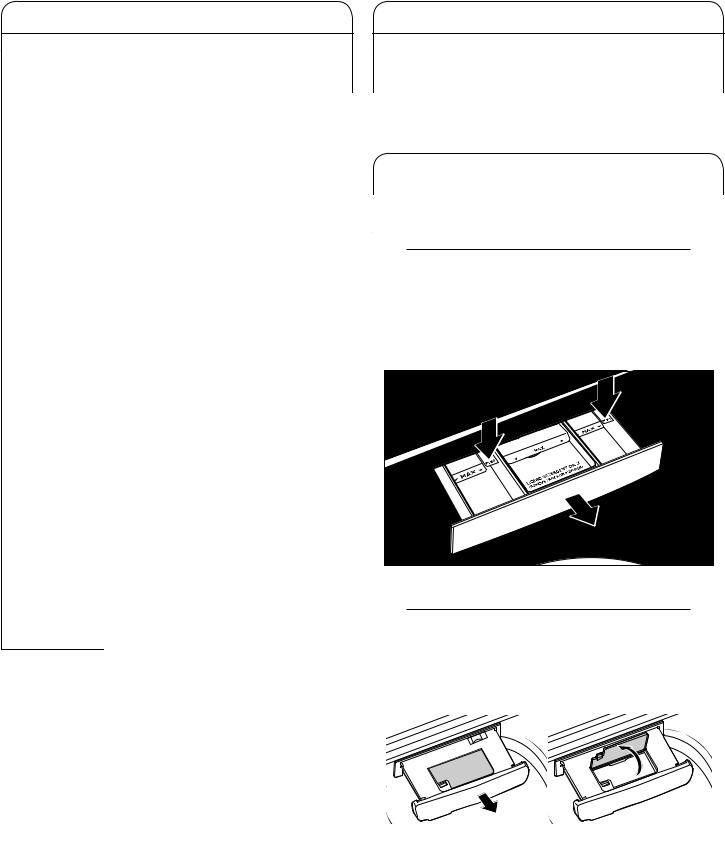
WASHER CARE (cont.)
2.Chlorine Bleach Procedure (Alternative):
a.Open the washer lid and remove any clothing or items.
b.Add 1 cup (236 mL) of liquid chlorine bleach to the bleach compartment.
NOTE: Use of more liquid chlorine bleach than is recommended above could cause washer damage over time.
c.Close the washer lid.
d.Do not add any detergent or other chemical to the washer when following this procedure.
e.Select the CLEAN WASHER cycle.
f.Touch and hold the START/PAUSE button to begin the cycle. The Clean Washer Cycle Operation is described below.
NOTE: For best results, do not interrupt cycle. If cycle must be interrupted, touch POWER. After the Clean Washer cycle has stopped, run a RINSE & SPIN cycle to
rinse cleaner from washer.
Description of Clean Washer Cycle Operation:
1.This cycle will fill to a water level higher than in normal wash cycles to provide rinsing at a level above the water line for normal wash cycle.
2.During this cycle, there will be some agitation and spinning to increase the removal of soils.
After this cycle is complete, leave the lid open to allow for better ventilation and drying of the washer interior.
Cleaning the Dispensers
After a period of using your washer, you may find some residue buildup in the washer’s dispensers. To remove residue from the dispensers, wipe them with a damp cloth and towel dry. Do not attempt to remove the dispensers or trim for cleaning. The dispensers and trim are not removable. If your model has a dispenser drawer, however, remove the drawer and clean it before or after you run the Clean Washer cycle. Use an all purpose surface cleaner, if needed.
Cleaning the Outside of the Washer
Use a soft, damp cloth or sponge to wipe away any spills. Use only mild soaps or cleaners when cleaning external washer surfaces.
IMPORTANT: To avoid damaging the washer’s finish, do not use abrasive products.
NON-USE AND VACATION CARE
Operate your washer only when you are home.
If moving, or not using your washer for a period of time, follow these steps:
1.Unplug or disconnect power to washer.
2.Turn off water supply to washer, to avoid flooding due to water pressure surge.
CLEANING YOUR DISPENSER
(*Varies according to model)
You may find laundry product residue leftover in your dispenser drawer or in bulk dispenser. To remove residue, follow below recommended cleaning procedures:
Dispenser Drawer
1.Pull drawer out until you feel resistance.
2.Push 2 tabs downward, and then continue pulling out.
3.Wash in warm, soapy water, using a mild detergent.
4.Rinse with warm water.
5.Air dry, or dry with a towel, then place back into slot.
IMPORTANT: Dispenser drawer and tray are not dishwasher safe.
Bulk Dispenser
1.Pull drawer completely out.
2.Open dispenser lid.
3.Rinse with warm water.
4.Air dry or dry with a towel, then place back into slot.
IMPORTANT: Bulk dispenser and tray are not dishwasher safe.
10
